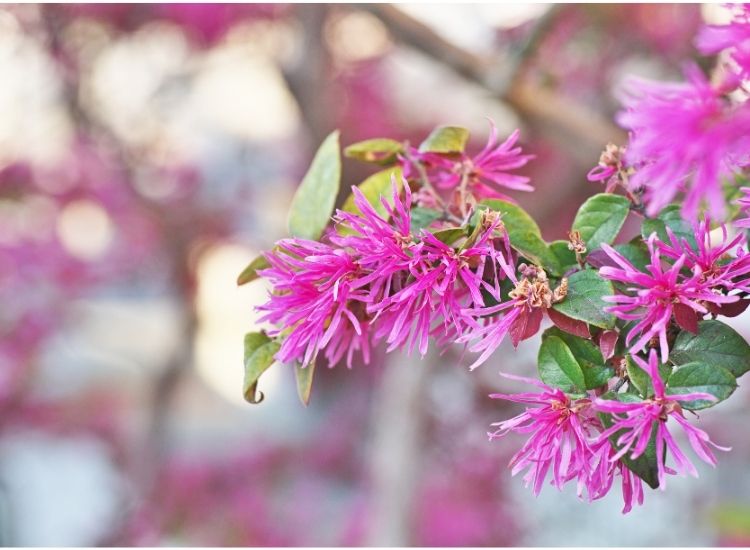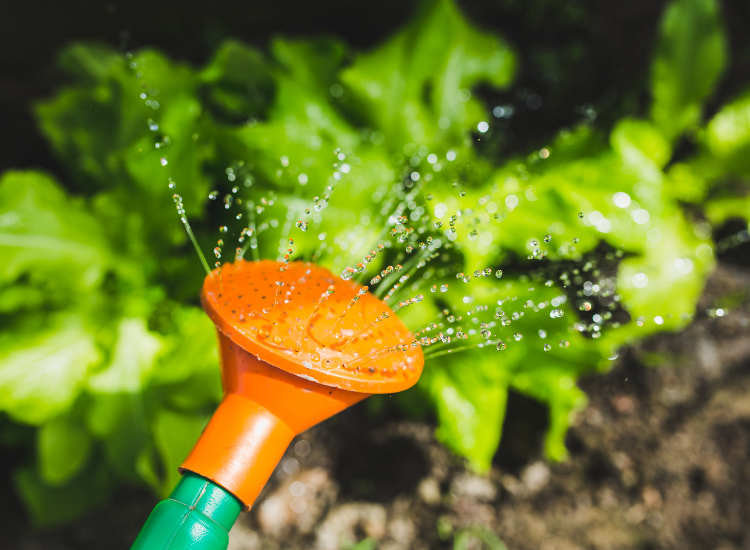- 11 Best Long Planter Boxes to Enhance Your Garden With - January 5, 2024
- Best Bulb Planters That You Should Consider for Your Garden - January 5, 2024
- Best Fiberglass Planters That Will Look Marvelous In Your Home - December 31, 2023
Loropetalums are excellent additions to your garden. Some people plant them for their pretty flowers and others like their colorful leaves. Yes, this plant has both.
What’s more, Loropetalums are shrubs, but you can prune them to form trees. Others have a weeping habit, which turns the leaves downward.
If you are looking to plant Loropetalums, what are the things you need to know?
What Is Loropetalum?
Loropetalum goes by several names, including Chinese fringe flower and Chinese witch hazel. Its Latin name, however, is Loropetalum Chinensis. This plant is native to Japan, the Himalayas, and of course, China.
It’s a variety of witch hazel. The fringe-looking flowers give it its name, which comes from the Greek words that mean “strap” and “petal.”

There are two colors for its foliage: green and burgundy. In a curious way, there are more of the burgundy leaves for loropetalum than green. Regardless of color, the small leaves of this plant are mostly oval-shaped.
Loropetalums are tall plants, with some varieties growing up to 15 feet (4.6 meters) tall. You can prune it if you like, cutting it down to shrub size.
Depending on the variety, Loropetalums can form mounds, stand upright, or spread. Loropetalums are often used as a border or a hedge. Some gardeners use it as an accent plant, mainly due to its beautiful flowers.
Location: Where to Plant Your Loropetalum
Loropetalum is best planted during spring or fall. Doing so will help the plant survive the extreme heat of summer or the cold of winter.
You should find a sunny spot for it, one where it can get at least six hours of sunlight. Be sure that the soil is well-draining as well.
Planting Loropetalums: The Things You Should Know
Loropetalums have root balls that you can plant. To make sure that your plant is healthy, you should have a hole that is at least twice or thrice the diameter of the root ball.
- If you are replanting a Loropetalums that was previously potted, you should tease out the roots that have clumped together before you plant it outdoors.
- Do not bury the entire rootball. The top of the rootball should be slightly above ground level. Fill the hole with enough soil to have the Loropetalums elevated somewhat, and then gently tap in to make the soil more compact and remove air pockets.
- Water the newly planted Loropetalums generously. It would help if you kept on watering once or twice a week until the plant is established.
- If you are planting several Loropetalums plants in a row, you should find out what cultivar it is so that you will know just how much space to give each plant. Some Loropetalums tend to droop to the ground, while others spread their foliage widely.
Planting Loropetalums from Seeds
Search the main canopy of your Loropetalums and find the seed pods. These seedpods may be on their own, or they may be in clusters, depending on your pruning habits.
Get these seed pods and then leave them inside a paper bag for about a couple of days. This process will allow the seed pods to dry out, making it easier for you to get the seeds.
One thing about Loropetalums is that the seed pods can eject the seeds, and they can fly all over the room. These seeds are shaped like a football, and they are black in color. There is a slick coat that covers the seeds.

Loropetalum seeds need cold stratification. According to Gardening Knowhow, cold stratification is when you use lower temperatures to break your seeds’ dormancy so that they would germinate.
Loropetalum seeds need a cold treatment. Put the seeds in a plastic bag for as long as six months. Make sure that the bag is sealed and that no air can get inside it.
After all those months, you can just put the seeds into the soil. These seeds can take about three to 12 months to germinate.
Watering Loropetalum: When and How Much
Watering your Loropetalums plants will help it grow a robust root system, allowing it to grow healthy and hardy.
For the most part, you can follow a specific watering schedule for Loropetalums:
- New plants need to be watered often because they are still growing new roots into the soil. This frequent watering is especially necessary if you plant your Loropetalums during the summer. In fact, if this is the case, then you will probably need to water them every other day.
- Established Loropetalums plants will also need regular watering. Most people find that they need to water their Loropetalums once a week. You will also need to consider if it rained that day, which means you can probably skip a session with the garden hose.
- Potted Loropetalums needs to have moist soil. These plants will need to be watered once or twice a week. You should water it deeply for potted plants until the water comes out of the drainage holes at the bottom.
- Loropetalums don’t like waterlogged soil in the winter.

Other Watering Tips for Your Loropetalum
- Water your plants in the morning. Doing so will give your Loropetalums the water they need, the moisture they love without the dangers of having moist leaves throughout the night. Wet leave may lead to fungal infections.
- Don’t water your Loropetalums if it rained the night before or during the day.
- Curled leaves are good signs that your plant needs to be watered. The tips are most often the first ones to wilt.
- Keep a regular watering schedule for healthy Loropetalums.
- Water your Loropetalums deeply so that the moisture will reach the roots. Deep watering will also encourage your plant to develop a strong and extensive root system.
- Established Loropetalums may be drought resistant, which means that it can forgive you if you forget to water it.
How Much Light Does Your Loropetalum Need?
Loropetalum enjoys full sun and light shade. At least six hours of full sun is needed to get the best color for the leaves and for the plant to bloom.
If you live in warmer areas, you might want to provide some shade during the hottest times of the day.
Fertilizer: Feeding Your Plant
Loropetalums generally do not require feeding when it’s set in the soil and is happily growing. But if you still like to feed your plants, you can use an all-purpose and slow-release fertilizer.
You can also buy a fertilizer that is precisely formulated for bushes, trees, and shrubs.
You may also want to add mulch around the partially exposed rootball. Using compose, wood chips, or straw, put a generous layer around the rootball and your plant’s base to discourage weeds from growing there. Mulching also helps keep the moisture in the soil.
However, be sure that you don’t cover the stems or the trunk with the mulch.
Fertilize your Loropetalums: A Cheat Sheet
- You should give your new plants a type of slow-release fertilizer, except when you used organic matter to amend the soil.
- You can also give newly planted Loropetalums a dose of root stimulator.
- After blooming, feed your plants again. Use a fertilizer that contains iron or sulfur. You can also use organic plant food.
- Fertilize again in mid or late summer
- For potted Loropetalums, use a slow-release fertilizer
Pruning Tips for Your Loropetalum
You can prune your Loropetalums if you want to maintain its shape. You can do this any time of the year, but if you live in an area with cold winters, you might want to avoid pruning two months before expecting the lower temperatures to come.
The reason behind this is that shearing your Loropetalums will encourage new growth. The fresh sprouts will probably not survive the frost when winter comes.
You can prune after the flowers bloom in the late winter.
How Do You Prune a Loropetalum
There are many reasons why you should prune your Loropetalums, and these dictate how you should go about shearing your plant.
- If you just want to keep it tidy, you can selectively prune by cutting away the wayward stems, dead branches, or broken stems. It would be best if you cut these a few inches above the break.
- Remove dead branches altogether. It would help if you cut dead branches at the origin. Cut away starting at some inches above the top of the dense part of your Loropetalums to keep the plant clean looking.
- Use a bypass hand pruner to do the job.
Shaping Your Loropetalum
Because your Loropetalums can grow to shrub size, it’s an excellent plant to shape. You can do so after the blooms die and cut away.
You can start with simple shapes, such as rectangles, globes, or even triangular pyramids. Or you can create a topiary out of your Loropetalums.
To create a formal shape or turn your Loropetalums into a hedge, you can use electric hedge trimmers or hedge shears.

You can prune your Loropetalums around twice or thrice a year. If you g more than that, and you might start stressing out your plant.
The stress is enough to weaken the plant because it’s working too much to produce new growth.
Pruning Your Lorepetalum into a Tree Form
There are varieties of Loropetalums that can grow as tall as six feet, and these can be pruned to form a tree. Cut the lower branches.
You can have a single or multiple trunks on your tree forming plant. If you want to cut a trunk, you should do so by pruning off about a quarter of an inch (6.35 millimeters) above the surface or at the origin.
Start pruning the lateral branches that are on the trunks that you intend to keep. It would be best if you also worked your way from the lowest branches up.
Some More Pruning Tips
- If you want to cut the size of the plant, you can prune the top heavily. To ensure that your plant can endure heavy pruning, do it right after the flowers have come out in the early spring.
- If you want it to look more like a tree than a shrub, prune the lower branches. It would help if you also did this after the plant has finished flowering in early spring.
Diseases and Pests
There are not a whole lot of pests and diseases that can threaten your Loropetalums plants, but it really does not mean that your Loropetalums is invincible. For one, if you put it in poorly draining soil, it can develop root rot in no time.
If you put it in alkaline soil, the leaves can be yellowed rather than green or burgundy. There are also some varieties of Loropetalums that are susceptible to bacterial gall disease.
This plant is also deer resistant.
Frequently Asked Questions
In this section, we answer the question most of our readers ask about Loropetalums:
Answer: The most common varieties of Loropetalums are those with burgundy leaves and pink flowers. Several cultivars fall into this category:
• Pizzazz gives you flowers that have the same colors are plums. It can grow up to eight feet (2.4 meters) tall. Its leaves are reddish-purple, but it will become darker as the plant matures.
• Plum Delight has its darker pink blooms and red-purple foliage. The leaves turn darker as the plant matures, turning into bronze and purple hues. Plum Delight can grow up to eight feet (2.4 meters) tall.
• Ever Red features a darker burgundy color for the leaves, as well as deep red flowers. It grows up to six feet (1.8 meters) tall and can spread just as far.
• Sizzling Pink starts with a deeper shade of burgundy and becomes purple as it matures. This cultivar can grow up to six feet (1.8 meters) tall and spread up to five feet (1.5 meters) in width.
• Purple Pixie is an excellent choice if you are looking for a Loropetalums that you can plan close together. This plant is a dwarf cultivar that can reach only two feet (0.6 meters) in height and features deep purple foliage and pink blooms.
• Aside from these cultivars, you also have Emerald Snow. Just by looking at its name, one can quickly tell that this Loropetalums has green leaves and white flowers.
• Snow Muffin first has light green leaves that slowly turn dark olive in color as it matures. It also has white flowers and can reach up to 3 feet (0.9 meters) in height.
This video shows you four different kinds of Loropetalums:
First, you should do a percolation test to see if you have well-draining soil or not. Clay soil can retain too much water to the point that your plants’ roots may stay in moist soil day in and day out.
Meanwhile, sandy soil may drain too fast, which is also wrong because your plants may not get the water they need to activate the ground’s nutrients. So your plants end up undernourished.
To test your soil on how well it drains, you can follow the steps in this video:
You can amend the soil to make it drain better. Add compost or other kinds of materials that are rich in organic matter. These additions will make the soil loose, so water can move freely without choking your plants.
Here are some materials that you can add to your garden soil if it doesn’t drain well:
On the other hand, if you have fast-draining soil, you can add some clay, silt, and ordinary garden soil to make it well-draining. Here’s a video that shows you how.
Bacterial gall causes growths that you see on the branches and other parts of a plant. As the name suggests, it is caused by bacteria and has affected more than 40 plant families.
Watch the following video to discover more about plant galls:
These growths can kill your plants. To get rid of it, you should remove it by using a sharp knife. You can scrape off the gall and the affected plant tissues. Seal off the wound with a pruning sealer.
If the plant still has bacterial gall problems, you should just cut away the affected branch or stem and then dispose of it in an area that’s far away from your plants.
The Cheat Sheet: Loropetalum
If you are planning to grow Loropetalums in your garden, here are the things that you should remember:
| Hardiness zones | 7 to 10 |
| Height | Up to 15 feet (4.5 meters) |
| Spread | Up to 10 feet (3.0 meters) |
| Sun exposure | Full sun to light shade |
| Blooms | Middle of spring, but other varieties may bloom again throughout the year; Tassel-like with ribbon petals |
| Toxicity | Not toxic to cats, children, and dogs |
Add Some Vibrant Color to Your Garden with Loropetalums
There is no reason why you shouldn’t grow Loropetalums in your garden. They are easy to care for, yet they add a nice touch of color in an otherwise all-green garden. They are also flexible, allowing you to use these plants as a hedge or a small tree.
Once you have the Loropetalums established, they do not require that much care. Just make sure that they get all the sun they need, water them properly, and feed them once in a while. Then prune them to your heart’s delight.

